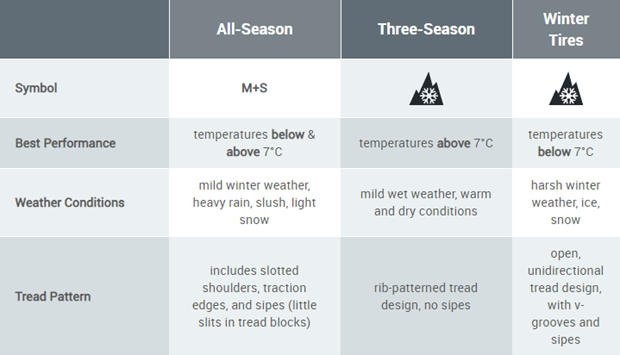It’s that time of year again – when the snowflakes start to fall and the mercury starts to drop, Canadians know that it’s time to get ready for the winters of the great white north.
We bundle ourselves up in winter coats, turn on the fireplaces in our homes – but what about our vehicles?
There are a few things you should do to ready your car for winter, including installing winter tires. If you haven’t switched out your all-season tires for winter ones, now is the perfect time to do so. But how much do we really know about this winter car necessity?
From why you need them, to when you should install them, here are 7 key facts to know about those all-important accessories for the chilly season in Canada: winter tires.
1. They’re Specifically Designed for Winter Driving Conditions
If you have all-season tires, you might be asking yourself why winter tires are even necessary. The fact of the matter is, winter tires are designed specifically to perform in ice, snow, slush, and low temperatures. Although all-season tires may be ideal for a variety of driving conditions, such as wet roads and light snowfall, they simply aren’t equipped for harsh Canadian winters – despite what the name suggests. That’s why, when the chilly season approaches, it’s vital that you switch them out for those sturdy winter variants.
2. Tread is Important
Winter tires are equipped with a special single-directional tread pattern that actually pushes away snow and ice. They also have a deeper tread depth than their all-season counterparts, for better performance in snowy road conditions. Winter tires are also made with special compounds that can withstand extreme low temperatures. All-season tires, on the other hand, are made using a closed tread pattern that is made for gripping roads and pushing away water through the spring, summer, and fall.
3. You Should Check Their Pressure Regularly
It’s important to check your winter tire pressure on a regular basis. As temperatures drop, the pressure in your tires will decrease – ensuring that your winter tires have the right amount of pressure will extend their tread life, reduce fuel consumption, and keep you and your passengers safe on the road.
Transport Canada recommends checking your tire pressure at least once a month.
4. You Need to Switch Out All Four Tires, Not Just Two
Regardless whether you have all-wheel drive, front-wheel drive, or rear-wheel drive, you must install all four winter tires – not just two. Switching out only the front, or back set of tires with winter variants may seem like a budget-friendly alternative to switching out all four tires – this is not only inefficient, but is very dangerous as well. Outfitting only the front or back of your vehicle with winter tires will not give you proper handling and control, as all four tires will not be working together properly. If you only outfit your car with two winter tires, you run the risk of your vehicle spinning out of control, and that is a risk no driver should take.
5. Price Doesn’t Always Equal Quality
To help you find the right winter tires for your vehicle and budget, Consumer Reports has released a list of top tire makers and the top tire models that they produce. It may come as a surprise that the best quality winter tires are not always the priciest. What’s more, winter tire prices are usually comparable to all-season tires, so there’s no reason not to switch out those all-season tires for winter tires.
6. They Can Help You Save On Car Insurance
Besides being vital for you and your passengers’ safety on the road, winter tires can actually help you save money on your car insurance!
With The Personal, you can save 5% off of your car insurance premium, simply for equipping your vehicle with four winter tires. Simply complete the auto insurance quote form, or call one of our licensed professionals, to see how you can save.
7. You Should Replace Them Regularly
How often should you replace your winter tires? When your tires’ tread has worn to 6/32nds of an inch, it’s time to get them replaced.
In order for winter tires to perform effectively on snowy roads, their tread should not be worn past 6/32″. At this point, your tires’ ability to keep their traction on icy and snowy roads is greatly reduced. When tread depth reaches 2/32″ your vehicle will have none, or very little, traction in the snow.
For a quick overview of winter tires, all-season tires, three-season tires, and the differences between them, refer to the chart below:

To find out more, call 1-888-476-8737 or visit thepersonal.com/https://ospe.on.ca/wp-content/uploads/2024/10/academy-banner-7.png
This article is being provided by OSPE on behalf of The Personal which has a group sponsorship agreement with regards to home and auto insurance for our members. The Personal refers to The Personal General Insurance Inc. in Quebec and The Personal Insurance Company in all other provinces and territories of Canada. The information and advice in this article are provided for informational purposes only. The Personal shall not be liable for any damages arising from any reliance upon such information or advice. The Personal recommends using caution and consulting an expert for comprehensive, expert advice. Auto Insurance is not available in MB, SK and BC due to government-run plans.





Comment (1)
i am wondering why my winter snow tires will loose over 5 lbs on a cold night.. and when its a warmer day they will come back close normal..
Leave a Comment